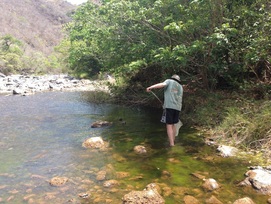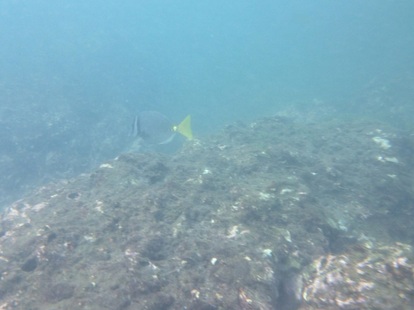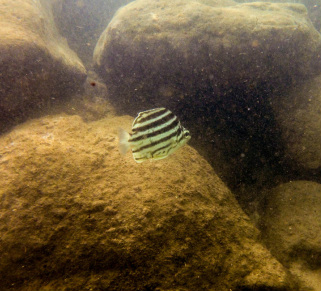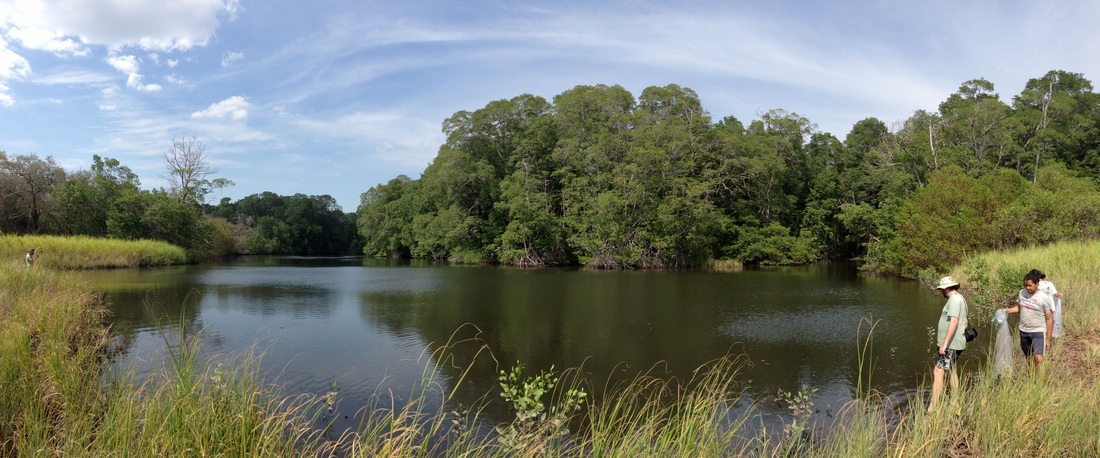 Caleb collecting at the type locality for P. santaelena Caleb collecting at the type locality for P. santaelena Since April I have been traveling every couple of weeks, and have gone on two international collecting trips, and three domestic trips. The first trip of this busy traveling season was a collecting trip to Costa Rica with my fellow lab mate Caleb McMahan. Even though he studies freshwater fishes and I study marine fishes, a convenient choice of study species brought both of our attention to Costa Rica. We planned our trip to be short and productive, staying in Costa Rica for only one week. Both of our study species are found in the same general area, the Pacific northwest of Costa Rica in the province of Guanacaste, allowing us to go in and collect everything very quickly. We flew into the Liberia airport with no difficulty and met two graduate students from the University of Costa Rica named Arturo Angulo and Carlos Garita. Caleb had already collected with both Carlos and Arturo in previous field expeditions, and their knowledge of the region helped us both tremendously in finding our fishes. We rented a 4x4 Toyota Hilux, and were soon off to our first field site. Caleb was interested in finding a rare livebearer, Poeciliopsis santaelena, which is only found in the Rio Potrero Grande in el Parque National Santa Rosa. April is the end of the dry season in that part of Costa Rica, and unfortunately when we first got there we were told that we might not be able to sample in the park because of several wildfires in the area. Luckily, none of the wildfires ended up being close to our collection site, and after meeting with several park employees and the director we had a personal escort through the park to our collecting site. During the dry season the river doesn't flow at all, and water is restricted to isolated pools in most areas of the river drainage. This made collecting quite simple for this species. Also the Toyota Hilux came in handy during this part of the trip, as there are not many roads in the national park and we had to go off roading the entire day to get to our field sites. We started sampling near the headwaters of the Rio Potrero Grande, and eventually made our way down to where it met the Pacific, collecting along the way (the picture above was taken close to where the river meets the Pacific Ocean). Not only was Caleb successful in getting his fish, but we also managed to document all of the other species that were found with it, and even film some swimming together in the deeper pools.  One of the marine fish we were after, Prionurus laticlavius, in its natural environment. One of the marine fish we were after, Prionurus laticlavius, in its natural environment. On the marine side of things I was in search of two sawtail surgeonfishes, Prionurus laticlavius and Prionurus punctatus, which overlap in their distributions in northwestern Costa Rica. After we collected Caleb's fish in the national park, and spent a couple days collecting in other nearby freshwater streams, we spent a couple of days collecting along some of the rocky beaches of Costa Rica. Luckily we were able to get both species I was after without too much difficulty and even managed to get some specimens off shore with the help of a local to the area, Minor Lara Victor, who has helped researchers in the past. In the end it was an extremely productive trip due to all the help we had from Arturo and Carlos, and also all the staff at the Parque National Santa Rosa.  Only a few short weeks after Costa Rica I was traveling again in search of a different fish. The destination for this trip was Kauai, with a very brief stop in my hometown of Tucson, Arizona right before the trip. While in Tucson I managed to stop by and visit Dr. Peter Reinthal and the ichthyology collection at the University of Arizona, my alma mater. It was great to be able to catch up with my former ichthyology professor and to get a chance to examine the Prionurus specimens they have in the collection. After that brief stop in Tucson I travelled on over the Pacific to Kauai. For this trip I was after Microcanthus strigatus, more commonly known as the stripey. For my dissertation I am examining anti-tropical distributions in reef fishes (fish found on both sides of the tropics, but not within), and the stripey is extremely interesting because this species is only found in four main areas: Hawaii, Japan, and both sides of Australia. It is not very common for a single species to have an anti-tropical distribution (usually it results in two sister species distributed on both sides of the tropics), so the stripey is a great opportunity to examine this distribution within one species. Unfortunately, this trip did not go as well as the Costa Rica trip. On the very first day of being in Kauai I was able to find the stripey in a small protected pool at Lydgate State Park (see picture). There is no fishing allowed in this pool, however, but it was nice to see the fish I was after on the first day. I spent the remainder of my trip trying to find this fish in a location where I could collect it, but was unable to find it for the entire trip. Field work doesn't always go as planned, and sometimes you just have to play the cards you're dealt. However, I cannot complain about these two trips, because successful or not, both were extremely fun trips. I am sure that I will be searching for the stripey again sometime in the near future. Comments are closed.
|
Archives
August 2021
Categories |
